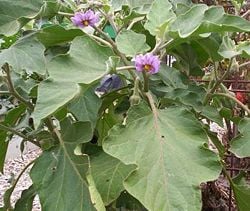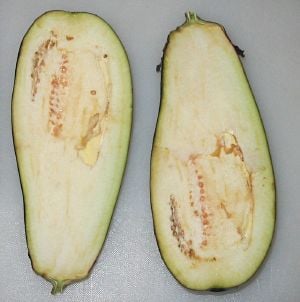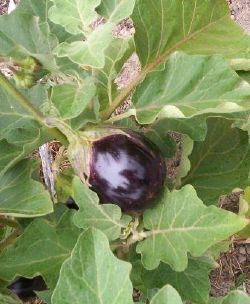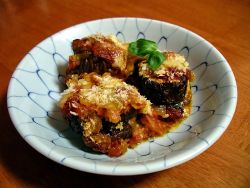Difference between revisions of "Eggplant" - New World Encyclopedia
Annie Gagne (talk | contribs) |
Annie Gagne (talk | contribs) (Applied ready tag) |
||
| Line 1: | Line 1: | ||
| + | |||
| + | {{ready}} | ||
| + | {{images OK}} | ||
{{Taxobox | {{Taxobox | ||
| color = lightgreen | | color = lightgreen | ||
Revision as of 08:04, 17 November 2007
| Eggplant / Aubergine | ||||||||||||||
|---|---|---|---|---|---|---|---|---|---|---|---|---|---|---|
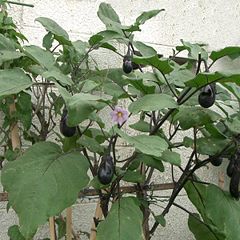 | ||||||||||||||
| Scientific classification | ||||||||||||||
| ||||||||||||||
| Solanum melongena L. |
The eggplant, aubergine or brinjal (Solanum melongena) is a plant of the family Solanaceae (also known as the nightshades) and genus Solanum. It bears a fruit of the same name, commonly used as a vegetable in cooking. As a night-shade, it is closely related to the tomato and potato and is native to southern India and Sri Lanka. It is a short-lived perennial plant often cultivated as an annual. It grows 40 to 150 cm (16 to 57 in) tall, with large coarsely lobed leaves that are 10 to 20 cm (4-8 in) long and 5 to 10 cm (2-4 in) broad. The stem is often spiny. The flowers are white to purple, with a five-lobed corolla and yellow stamens. The fruit is fleshy, less than 3 cm in diameter on wild plants, but much larger in cultivated forms. (Semi-)wild types can grow much larger, to 225 cm (7 ft) with large leaves over 30 cm (12 in) long and 15 cm (6 in) broad. The fruit contains numerous small, soft seeds which are edible.
History
The eggplant is an important food crop grown for its large, pendulous purple or white fruit. It has been cultivated in southern and eastern Asia since prehistory but appears to have become known to the Western world no earlier than ca. 1500 C.E. The numerous Arabic and North African names for it, along with the lack of ancient Greek and Roman names, indicate that it was introduced throughout the Mediterranean area by the Arabs in the early Middle Ages. The scientific name Solanum melongena is derived from a 16th century Arabic term for one kind of eggplant.
The name eggplant developed in the United States, Australia, and Canada because the fruits of some 18th century European cultivars were yellow or white and resembled goose or hen's eggs. The name aubergine in British English developed based on the French aubergine (as derived from Catalan albergínia). In Indian and South African English, the fruit is known as a "brinjal." Aubergine and brinjal, with their distinctive br-jn or brn-jl aspects, derive from Arabic and Sanskrit.
Because of the eggplant's relationship with the Solanaceae (nightshade) family, it was at one time believed to be poisonous. While it is true that eggplant can generally be eaten without ill effect by most people, for some, the eating of eggplant as well as other edible nightshade plants (tomato, potato, and capsicum/peppers) can indeed be harmful. Some eggplants can be rather bitter, which can irritate the stomach lining and cause gastritis. More importantly, nightshades, including eggplant, can cause or significantly worsen arthritis and should be avoided by those sensitive to them. [1]
Cultivated varieties
The most widely grown cultivated varieties (cultivars) in Europe and North America today are elongated ovoid, 12-25 cm long (4 1/2 to 9 in) and 6-9 cm broad (2 to 4 in) with a dark purple skin. A much wider range of shapes, sizes and colors is grown in India and elsewhere in Asia. Larger varieties weighing up to a kilogram grow in the region between the Ganges and Yamuna rivers, while smaller varieties are found elsewhere. Colors vary from white to yellow or green as well as reddish-purple and dark purple. Some cultivars have a color gradient, from white at the stem to bright pink to deep purple or even black. Green or purple cultivars with white striping also exist. Chinese eggplants are commonly shaped like a narrower, slightly pendulous cucumber, and sometimes were called Japanese eggplants in North America.
Oval or elongated oval-shaped and black-skinned cultivars include: 'Harris Special Hibush', 'Burpee Hybrid', 'Black Magic', 'Classic', 'Dusky', and 'Black Beauty'. Long, slim cultivars with purple-black skin include: 'Little Fingers', 'Pingtung Long' and 'Tycoon'; with green skin: 'Louisiana Long Green' and 'Thai (Long) Green'; with white skin: 'Dourga'. Traditional, white-skinned, oval-shaped cultivars include 'Casper' and 'Easter Egg'. Bicolored cultivars with color gradient include: 'Rosa Bianca', and 'Violetta di Firenze'. Bicolored cultivars with striping include: 'Listada de Gandia' and 'Udumalapet'. Matti Gulla or Matti brinjal is a unique variety of eggplant grown in the village of Matti in the Udupi district of India; it is light green in color and round in shape. Some brinjals of this variety weigh more than one kilogram.
Cooking
The raw fruit can have a somewhat bitter taste, but becomes tender when cooked and develops a rich, complex flavor. Salting and then rinsing the sliced eggplant (known as "degorging") can soften and remove much of the bitterness. Some modern varieties do not need this treatment, as they are less bitter. The eggplant is capable of absorbing large amounts of cooking fats and sauces, allowing for very rich dishes, but the salting process will reduce the amount of oil absorbed. The fruit flesh is smooth; as in the related tomato, the numerous seeds are soft and edible along with the rest of the fruit. The thin skin is also edible, so that the eggplant need not be peeled.
The eggplant is used in cuisines from Japan to Spain. It is often stewed, as in the French ratatouille, the Italian melanzane alla parmigiana, the Greek moussaka, and many South Asian dishes. It may also be roasted in its skin until charred, so that the pulp can be removed and blended with other ingredients such as lemon, tahini, and garlic, as in the Middle Eastern dish baba ghanoush and the similar Greek dish melitzanosalata or the Indian dishes of Baigan Bhartha or Gojju. It can be sliced, battered, and deep-fried, then served with various sauces which may be based on yoghurt, tahini, or tamarind. Grilled and mashed eggplant mixed with onions, tomatoes, and spices makes the Indian dish baingan ka bhartha. The eggplant can also be stuffed with meat, rice, or other fillings and then baked. In the Caucasus, for example, it is fried and stuffed with walnut paste to make nigvziani badrijani.
As a native plant, it is widely used in South Indian cuisine, for example in sambhar, chutney, curries, and achaar. Owing to its versatile nature and wide use in both everyday and festive South Indian food, it is often described (under the name brinjal) as the 'King of Vegetables' in South India. In the cuisine of North Karnataka in South India, Brinjal is stuffed with ground coconut, peanuts, and masala and then cooked in oil. This is called yengai in the local language and when eaten with sorghum bread, jolada rotti, is a delicacy.
Cultivation
In tropical and subtropical climates, the eggplant can be sown directly into the garden. Eggplant grown in temperate climates fares better when transplanted into the garden after all danger of frost is past. Seeds are typically started eight to ten weeks prior to the anticipated frost-free date.
Many pests and diseases which afflict other solanaceous vegetables, such as tomato, pepper (capsicum), and potato, are also troublesome to eggplants. For this reason, it should not be planted in areas previously occupied by its close relatives. Four years should separate successive crops of eggplants. Common North American pests include the potato beetle, flea beetle, aphids and spider mites. Many of these can be controlled using Bacillus thurengensis (Bt), a bacterium that attacks the soft-bodied larvae. (Adults can be removed by hand, though flea beetles can be especially difficult to control.) Good sanitation and crop-rotation practices are extremely important for controlling fungal disease, the most serious of which is Verticillium.
Spacing should be 45 cm (18 in) to 60 cm (24 in) between plants, depending on cultivar, and 60 cm to 90 cm (24 to 36 in) between rows, depending on the type of cultivation equipment being used. Mulching will help conserve moisture and prevent weeds and fungal diseases. The flowers are relatively unattractive to bees and the first blossoms often do not set fruit. Hand pollination will improve the set of the first blossoms. Fruits are typically cut from the vine just above the calyx owing to the semi-woody stems.
Statistics
According to the USDA, production of eggplant is highly concentrated, with 93 percent of output coming from seven countries. China is the top producer(55% of world output) and India (28%); Egypt, Turkey, and Japan round out the top producing nations. United States is the 20th largest producer. More than 4 million acres (16,000 km²) are devoted to the cultivation of eggplant in the world.[2]
Health
Studies of the Institute of Biology of São Paulo State University, Brazil (Instituto de Biociências of the UNESP de Botucatu, São Paulo) showed that eggplant is effective in the treatment of high blood cholesterol hypercholesterolemia and in the control of cholesterol (about 30% reduction).[citation needed]
Eggplant is richer in nicotine than any other edible plant. However, the amount of nicotine from eggplant or any other food is negligible compared to passive smoking. [3]
See also
- Solanum gilo
- Caviar d'aubergine (French Provencal Cuisine)
- Eggplant salad
- Baba ghanoush
- Salată de vinete (Romanian cuisine)
- Escalivada (Catalan cuisine)
- Musakka (Turkish cuisine)
- Mutabbal (Lebanese cuisine)
- Thai eggplant
- Mirza Qasimi
Image gallery
- Eggplant mutant.jpg
a deformed eggplant
Notes
- ↑ Childers, N.F. (PhD) and Margoles, M.S. (MD). (1993). An apparent relation of nightshades (Solanaceae) to arthritis. Journal of Neurological and Orthopedic Medical Surgery. 12: 227-231. (article provided on-line by the Arthritis Nightshades Research Foundation | http://www.noarthritis.com/research.htm Retrieved November 17, 2007
- ↑ Vegetables and Melons Outlook/VGS-318 (PDF). Economic Research Service pp. 23. USDA (2006-12-14). Retrieved November 17, 2007.
- ↑ Domino, Edward F., Hornbach, Erich, and Demana, Tsenge The Nicotine Content of Common Vegetables, The New England Journal of Medicine, Volume 329:437 August 5, 1993 Number 6 Retrieved November 17, 2007
External links
All links retrieved November 17, 2007
- Aubergine: Plants for a Future database
- Solanum melongena L. on Solanaceae Source - Images, specimens and a full list of scientific synonyms previously used to refer to the eggplant.
- Nutrition facts
Credits
New World Encyclopedia writers and editors rewrote and completed the Wikipedia article in accordance with New World Encyclopedia standards. This article abides by terms of the Creative Commons CC-by-sa 3.0 License (CC-by-sa), which may be used and disseminated with proper attribution. Credit is due under the terms of this license that can reference both the New World Encyclopedia contributors and the selfless volunteer contributors of the Wikimedia Foundation. To cite this article click here for a list of acceptable citing formats.The history of earlier contributions by wikipedians is accessible to researchers here:
The history of this article since it was imported to New World Encyclopedia:
Note: Some restrictions may apply to use of individual images which are separately licensed.
